Nanomaterials in the Environment: Research Hotspots and Trends
Abstract
1. Introduction
2. Data
3. Method
3.1. Holistic Approach
- Step 1: Raw files in plain texts were automatically merged into available Excel files with abbreviated titles by Bibexcel [27] (a simple analytical tool). In the file, different items were separated by tab-delimited for facilitating importing into Excel.
- Step 2: The numbers of publications by various countries, institutions, journals and authors were filtered by Excel.
- Step 3: Relationship of co-citation (i.e., two articles were cited by another article at the same time) was analyzed with Citespace for the Excel files produced in Step 1.
- Step 4: High-frequency words in all publication titles were counted in R. A co-word analysis provides the words frequency of co-occurrence to analysis the value of words. Afterwards, a correlation analysis was delivered by R for revealing the relationship of the high-frequency words.
3.2. A Frequency Analysis of Words in Titles
4. Frequency Analysis of Publication Outputs
4.1. Publication Outputs
4.2. Countries/Territories and Institutions
4.3. Web of Science Categories and Journals
5. Co-Citation and Word-Correlation Analyses
5.1. A Co-Citation Analysis
5.2. Correlation of High-Frequency Words in Titles
6. Conclusions
Supplementary Materials
Author Contributions
Funding
Conflicts of Interest
References
- Gleiter, H.; Marquardt, P. Nanocrystalline structures—an approach to new materials? Z. Metallkd. 1984, 75, 263–267. [Google Scholar]
- Liu, Z.; Yin, Y.; Liu, W.; Dunford, M. Visualizing the intellectual structure and evolution of innovation systems research: a bibliometric analysis. Scientometrics 2015, 103, 135–158. [Google Scholar] [CrossRef]
- Qin, X.S.; Huang, G.H.; He, L. Simulation and optimization technologies for petroleum waste management and remediation process control. J. Environ. Manag. 2009, 90, 54–76. [Google Scholar] [CrossRef]
- Li, W.; Li, Y.P.; Li, C.H.; Huang, G.H. An inexact two-stage water management model for planning agricultural irrigation under uncertainty. Agric. Water Manag. 2010. [Google Scholar] [CrossRef]
- Gottschalk, F.; Sonderer, T.; Scholz, R.W.; Nowack, B. Modeled environmental concentrations of engineered nanomaterials (TiO2, ZnO, Ag, CNT, fullerenes) for different regions. Environ. Sci. Technol. 2009, 43, 9216–9222. [Google Scholar] [CrossRef] [PubMed]
- Mortimer, M.; Kasemets, K.; Kahru, A. Toxicity of ZnO and CuO nanoparticles to ciliated protozoa Tetrahymena thermophila. Toxicology 2010. [Google Scholar] [CrossRef] [PubMed]
- Zhai, M.; Huang, G.; Liu, L.; Zheng, B.; Guan, Y. Inter-regional carbon flows embodied in electricity transmission: network simulation for energy-carbon nexus. Renew. Sustain. Energy Rev. 2020, 118, 109511. [Google Scholar] [CrossRef]
- Hu, J.; Chen, C.; Zhu, X.; Wang, X. Removal of chromium from aqueous solution by using oxidized multiwalled carbon nanotubes. J. Hazard. Mater. 2009. [Google Scholar] [CrossRef]
- Cañas, J.E.; Qi, B.; Li, S.; Maul, J.D.; Cox, S.B.; Das, S.; Green, M.J. Acute and reproductive toxicity of nano-sized metal oxides (ZnO and TiO 2) to earthworms (Eisenia fetida). J. Environ. Monit. 2011, 13, 3351–3357. [Google Scholar] [CrossRef]
- Li, Q.; Mahendra, S.; Lyon, D.Y.; Brunet, L.; Liga, M.V.; Li, D.; Alvarez, P.J.J. Antimicrobial nanomaterials for water disinfection and microbial control: Potential applications and implications. Water Res. 2008, 42, 4591–4602. [Google Scholar] [CrossRef]
- Thelwall, M. Bibliometrics to webometrics. J. Inf. Sci. 2008, 34, 605–621. [Google Scholar] [CrossRef]
- Wagner, C.S.; Roessner, J.D.; Bobb, K.; Klein, J.T.; Boyack, K.W.; Keyton, J.; Rafols, I.; Börner, K. Approaches to understanding and measuring interdisciplinary scientific research (IDR): A review of the literature. J. Informetr. 2011, 5, 14–26. [Google Scholar] [CrossRef]
- Leung, X.Y.; Sun, J.; Bai, B. Bibliometrics of social media research: A co-citation and co-word analysis. Int. J. Hosp. Manag. 2017, 66, 35–45. [Google Scholar] [CrossRef]
- Liao, H.; Tang, M.; Luo, L.; Li, C.; Chiclana, F.; Zeng, X.J. A bibliometric analysis and visualization of medical big data research. Sustainability 2018, 10, 166. [Google Scholar] [CrossRef]
- Zheng, M.; Fu, H.Z.; Ho, Y.S. Research trends and hotspots related to ammonia oxidation based on bibliometric analysis. Environ. Sci. Pollut. Res. 2017, 24, 20409–20421. [Google Scholar] [CrossRef] [PubMed]
- Li, J.; Zhang, B.; Liu, Y.; Huang, W. Global research trends on membrane biological reactor (MBR) for wastewater treatment and reuse from 1982 to 2013 A bibliometric analysis. Electron. Libr. 2016, 34, 945–957. [Google Scholar] [CrossRef]
- Huai, C.; Chai, L. A bibliometric analysis on the performance and underlying dynamic patterns of water security research. Scientometrics 2016, 108, 1531–1551. [Google Scholar] [CrossRef]
- Kurtz, M.J.; Bollen, J. Usage bibliometrics. Annu. Rev. Inf. Sci. Technol. 2010, 44, 1–64. [Google Scholar] [CrossRef]
- Blinova, I.; Niskanen, J.; Kajankari, P.; Kanarbik, L.; Käkinen, A.; Tenhu, H.; Penttinen, O.P.; Kahru, A. Toxicity of two types of silver nanoparticles to aquatic crustaceans Daphnia magna and Thamnocephalus platyurus. Environ. Sci. Pollut. Res. 2013, 20, 3456–3463. [Google Scholar] [CrossRef]
- Huang, G.H.; Huang, Y.F.; Wang, G.Q.; Xiao, H.N. Development of a forecasting system for supporting remediation design and process control based on NAPL-biodegradation simulation and stepwise-cluster analysis. Water Resour. Res. 2006. [Google Scholar] [CrossRef]
- Borgman, C.L.; Furner, J. Scholarly communication and bibliometrics. Annu. Rev. Inf. Sci. Technol. 2005, 36, 2–72. [Google Scholar] [CrossRef]
- Kajikawa, Y.; Yoshikawa, J.; Takeda, Y.; Matsushima, K. Tracking emerging technologies in energy research: Toward a roadmap for sustainable energy. Technol. Forecast. Soc. Chang. 2008, 75, 771–782. [Google Scholar] [CrossRef]
- Ho, Y.S. Top-cited articles in chemical engineering in science citation index expanded: A bibliometric analysis. Chin. J. Chem. Eng. 2012, 20, 478–488. [Google Scholar] [CrossRef]
- Daim, T.U.; Rueda, G.; Martin, H.; Gerdsri, P. Forecasting emerging technologies: Use of bibliometrics and patent analysis. Technol. Forecast. Soc. Chang. 2006, 73, 981–1012. [Google Scholar] [CrossRef]
- Batagelj, V.; Mrvar, A. Pajek—Analysis and visualization of large networks. In Lecture Notes in Computer Science; Including Subseries Lecture Notes in Artificial Intelligence and Lecture Notes in Bioinformatics; Springer: Berlin, Germany, 2002. [Google Scholar]
- Van Eck, N.J.; Waltman, L. Software survey: VOSviewer, a computer program for bibliometric mapping. Scientometrics 2010, 84, 523–538. [Google Scholar] [CrossRef] [PubMed]
- Persson, O.; Danell, R.; Schneider, J.W. How to use Bibexcel for various types of bibliometric analysis. In Celebrating Scholarly Communication Studies: A Festschrift for Olle Persson at his 60th Birthday; ISSI: Milpitas, CA, USA, 2009. [Google Scholar]
- Benesty, J.; Chen, J.; Huang, Y.; Cohen, I. Pearson Correlation Coefficient. In Noise Reduction in Speech Processing; Springer: Berlin, Germany, 2009. [Google Scholar]
- Ho, Y.-S.; Satoh, H.; Lin, S.-Y. Japanese Lung Cancer Research Trends and Performance in Science Citation Index. Intern. Med. 2010, 49, 2219–2228. [Google Scholar] [CrossRef]
- Hou, J.; Wu, Y.; Li, X.; Wei, B.; Li, S.; Wang, X. Toxic effects of different types of zinc oxide nanoparticles on algae, plants, invertebrates, vertebrates and microorganisms. Chemosphere 2018, 193, 852–860. [Google Scholar] [CrossRef]
- Toropova, A.P.; Toropov, A.A.; Benfenati, E.; Korenstein, R.; Leszczynska, D.; Leszczynski, J. Optimal nano-descriptors as translators of eclectic data into prediction of the cell membrane damage by means of nano metal-oxides. Environ. Sci. Pollut. Res. 2015, 22, 745–757. [Google Scholar] [CrossRef]
- Zhou, N.; Dang, C.; Zhao, Z.; He, S.; Zheng, M.; Liu, W.; Wang, X. Role of sludge retention time in mitigation of nitrous oxide emission from a pilot-scale oxidation ditch. Bioresour. Technol. 2019. [Google Scholar] [CrossRef]
- Chen, C. The CiteSpace Manual; Drexel University College of Computing & Informatics: Philadelphia, PA, USA, 2014. [Google Scholar]
- Oberdörster, E. Manufactured nanomaterials (fullerenes, C60) induce oxidative stress in the brain of juvenile largemouth bass. Environ. Health Perspect. 2004. [Google Scholar] [CrossRef]
- Jia, G.; Wang, H.; Yan, L.; Wang, X.; Pei, R.; Yan, T.; Zhao, Y.; Guo, X. Cytotoxicity of carbon nanomaterials: Single-wall nanotube, multi-wall nanotube, and fullerene. Environ. Sci. Technol. 2005, 39, 1378–1383. [Google Scholar] [CrossRef]
- Lecoanet, H.F.; Wiesner, M.R. Velocity effects on fullerene and oxide nanoparticle deposition in porous media. Environ. Sci. Technol. 2004, 38, 4377–4382. [Google Scholar] [CrossRef] [PubMed]
- Fortner, J.D.; Lyon, D.Y.; Sayes, C.M.; Boyd, A.M.; Falkner, J.C.; Hotze, E.M.; Alemany, L.B.; Tao, Y.J.; Guo, W.; Ausman, K.D.; et al. C60 in water: Nanocrystal formation and microbial response. Environ. Sci. Technol. 2005, 39, 4307–4316. [Google Scholar] [CrossRef] [PubMed]
- Chen, K.L.; Elimelech, M. Influence of humic acid on the aggregation kinetics of fullerene (C60) nanoparticles in monovalent and divalent electrolyte solutions. J. Colloid Interface Sci. 2007, 309, 126–134. [Google Scholar] [CrossRef] [PubMed]
- Petosa, A.R.; Jaisi, D.P.; Quevedo, I.R.; Elimelech, M.; Tufenkji, N. Aggregation and deposition of engineered nanomaterials in aquatic environments: Role of physicochemical interactions. Environ. Sci. Technol. 2010, 44, 6532–6549. [Google Scholar] [CrossRef]
- Nowack, B.; Bucheli, T.D. Occurrence, behavior and effects of nanoparticles in the environment. Environ. Pollut. 2007, 150, 5–22. [Google Scholar] [CrossRef]
- Heinlaan, M.; Ivask, A.; Blinova, I.; Dubourguier, H.C.; Kahru, A. Toxicity of nanosized and bulk ZnO, CuO and TiO2 to bacteria Vibrio fischeri and crustaceans Daphnia magna and Thamnocephalus platyurus. Chemosphere 2008, 71, 1308–1316. [Google Scholar] [CrossRef]
- Savage, N.; Diallo, M.S. Nanomaterials and water purification: Opportunities and challenges. J. Nanoparticle Res. 2005, 7, 331–342. [Google Scholar] [CrossRef]
- Ahmed, F.; Rodrigues, D.F. Investigation of acute effects of graphene oxide on wastewater microbial community: A case study. J. Hazard. Mater. 2013, 256, 33–39. [Google Scholar] [CrossRef]
- Sun, T.Y.; Gottschalk, F.; Hungerbühler, K.; Nowack, B. Comprehensive probabilistic modelling of environmental emissions of engineered nanomaterials. Environ. Pollut. 2014, 185, 69–76. [Google Scholar] [CrossRef]
- Nel, A.; Xia, T.; Mädler, L.; Li, N. Toxic potential of materials at the nanolevel. Science 2006, 311, 622–627. [Google Scholar] [CrossRef] [PubMed]
- Mueller, N.C.; Nowack, B. Exposure modeling of engineered nanoparticles in the environment. Environ. Sci. Technol. 2008. [Google Scholar] [CrossRef] [PubMed]
- Klaine, S.J.; Alvarez, P.J.J.; Batley, G.E.; Fernandes, T.F.; Handy, R.D.; Lyon, D.Y.; Mahendra, S.; McLaughlin, M.J.; Lead, J.R. Nanomaterials in the environment: Behavior, fate, bioavailability, and effects. Environ. Toxicol. Chem. 2008, 27, 1825–1851. [Google Scholar] [CrossRef]
- Hu, H.; Han, L.; Yu, M.; Wang, Z.; Lou, X.W. Metal-organic-framework-engaged formation of Co nanoparticle-embedded carbon@Co9S8 double-shelled nanocages for efficient oxygen reduction. Energy Environ. Sci. 2016. [Google Scholar] [CrossRef]
- Wang, Q.; Yang, Z.; Yang, Y.; Long, C.; Li, H. A bibliometric analysis of research on the risk of engineering nanomaterials during 1999-2012. Sci. Total Environ. 2014, 473, 483–489. [Google Scholar] [CrossRef]


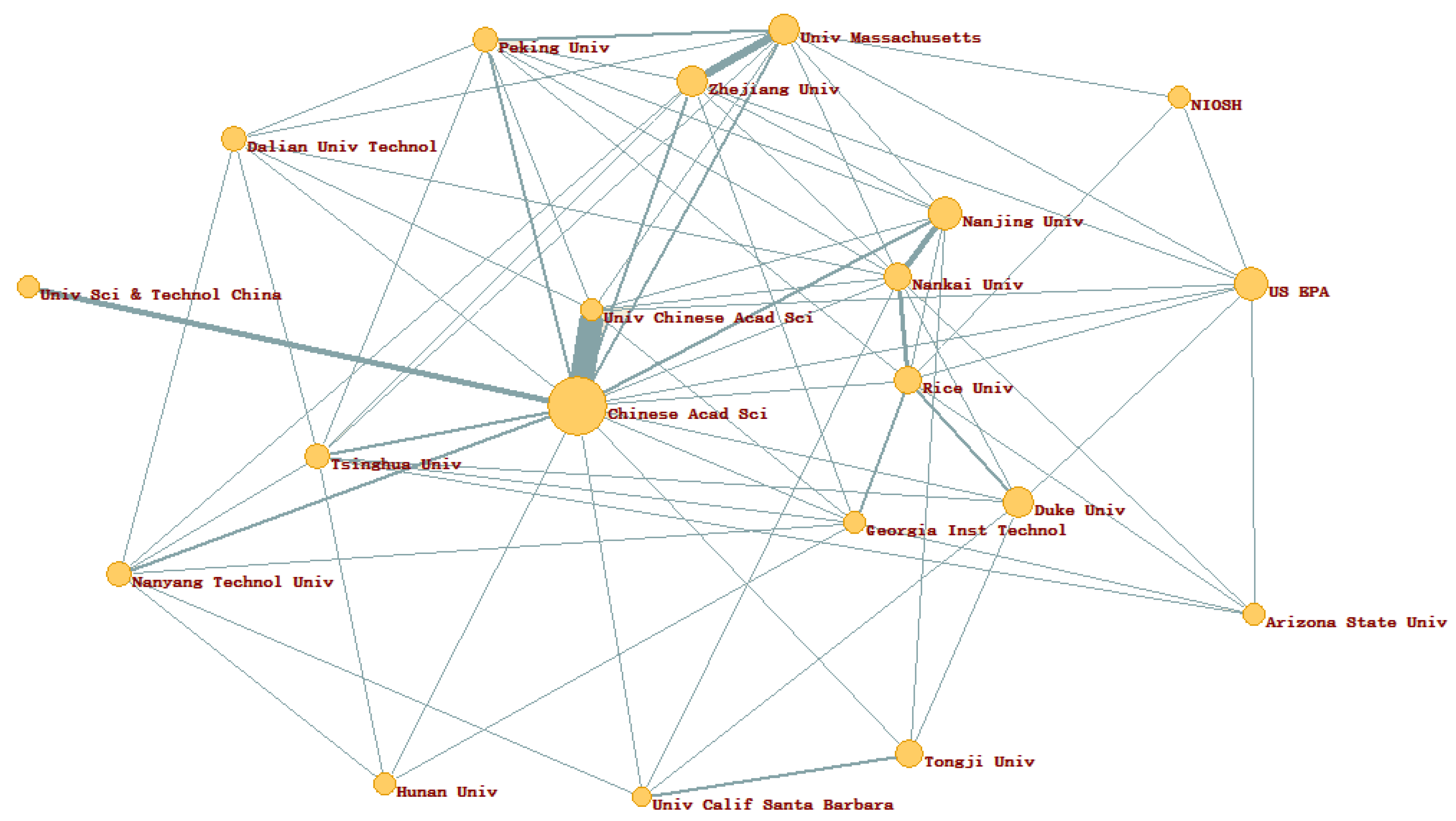
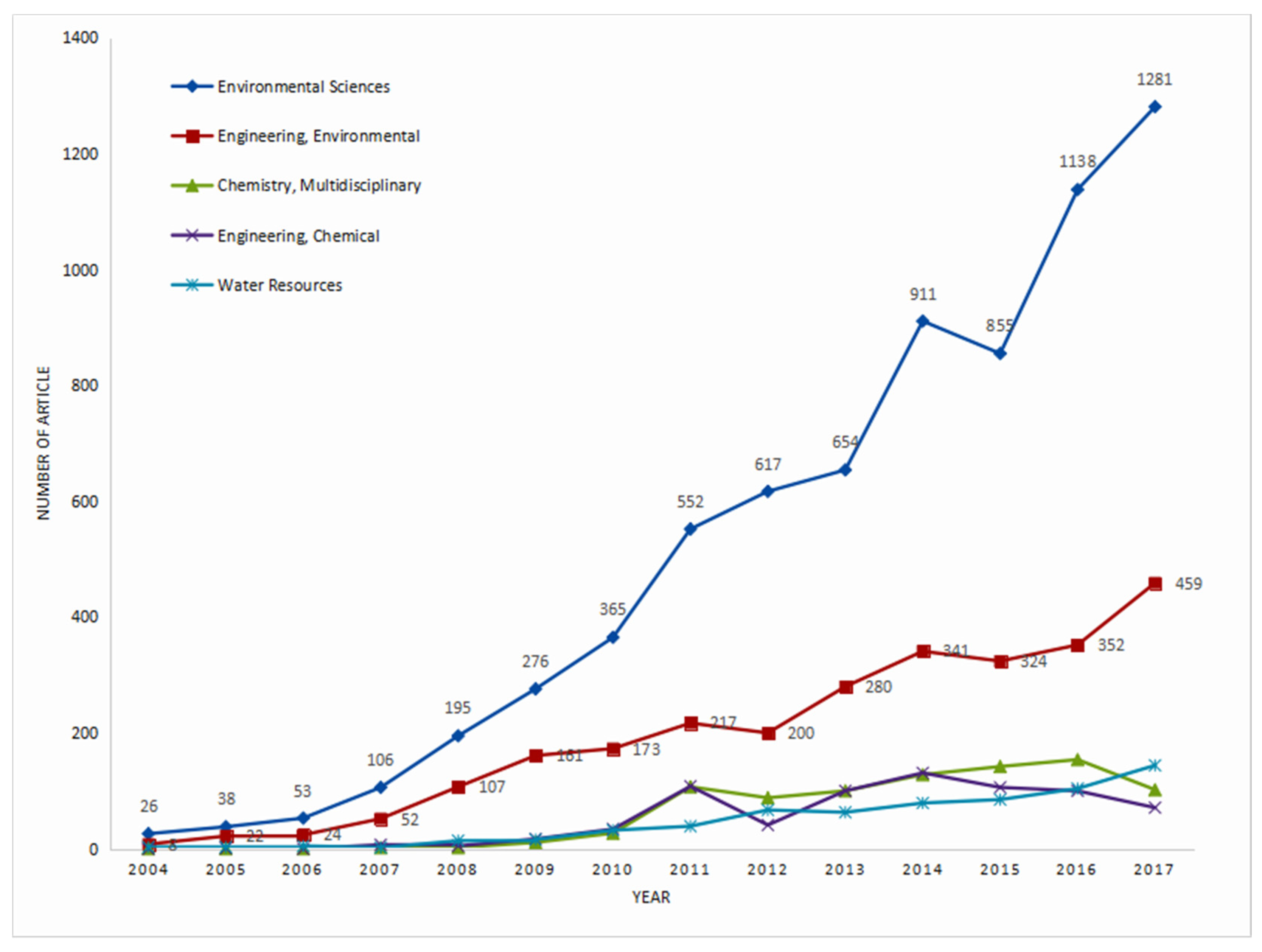

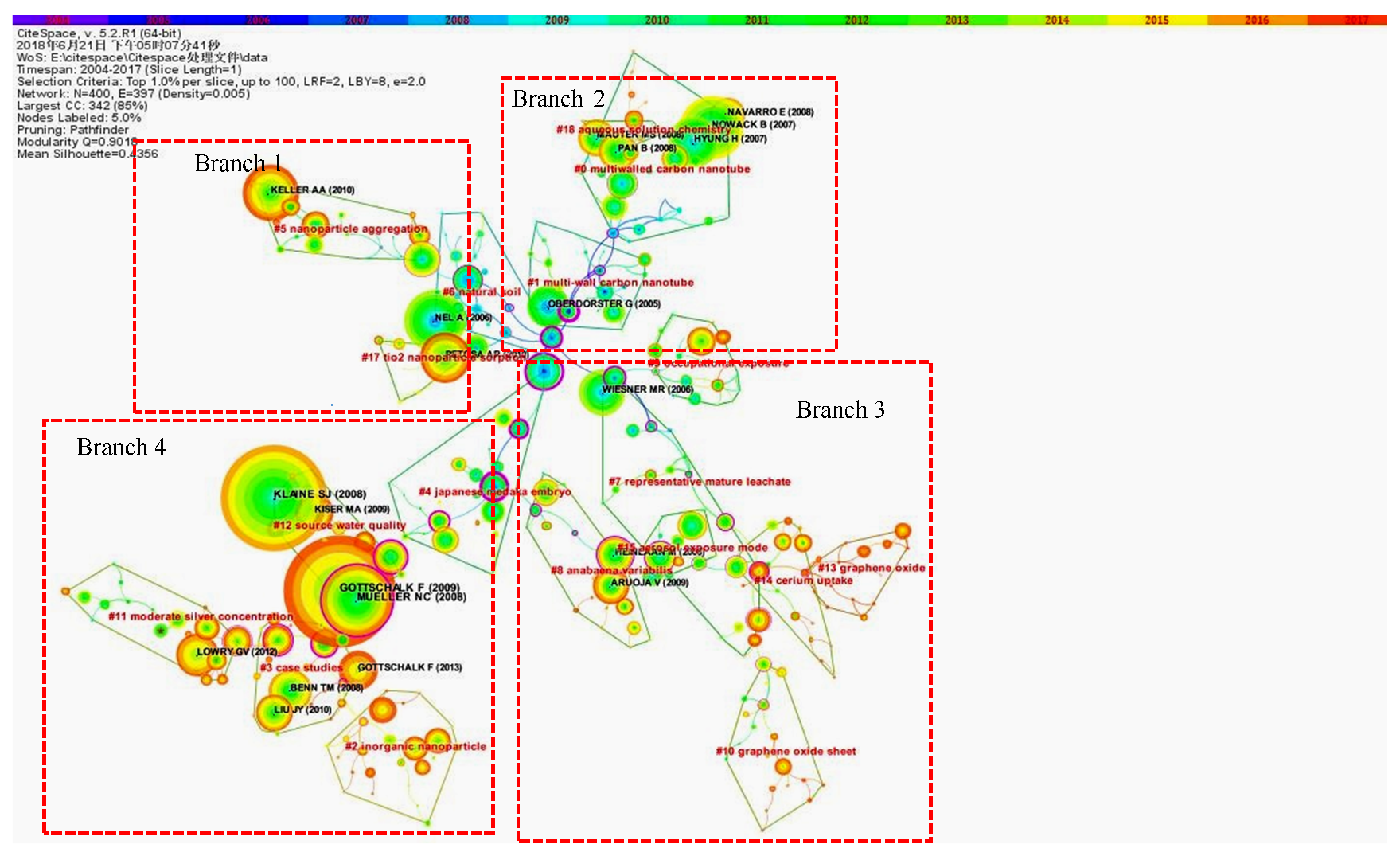
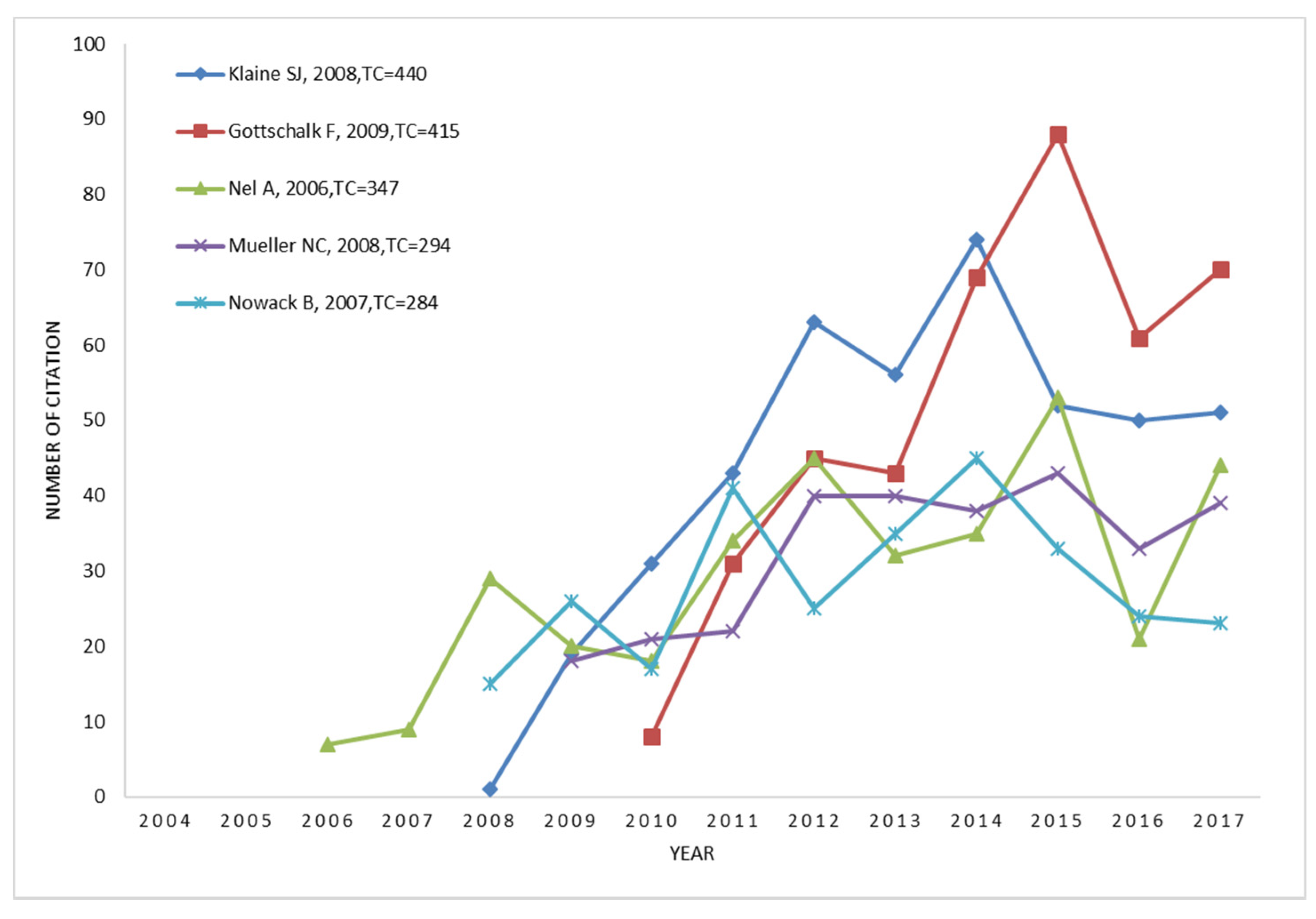
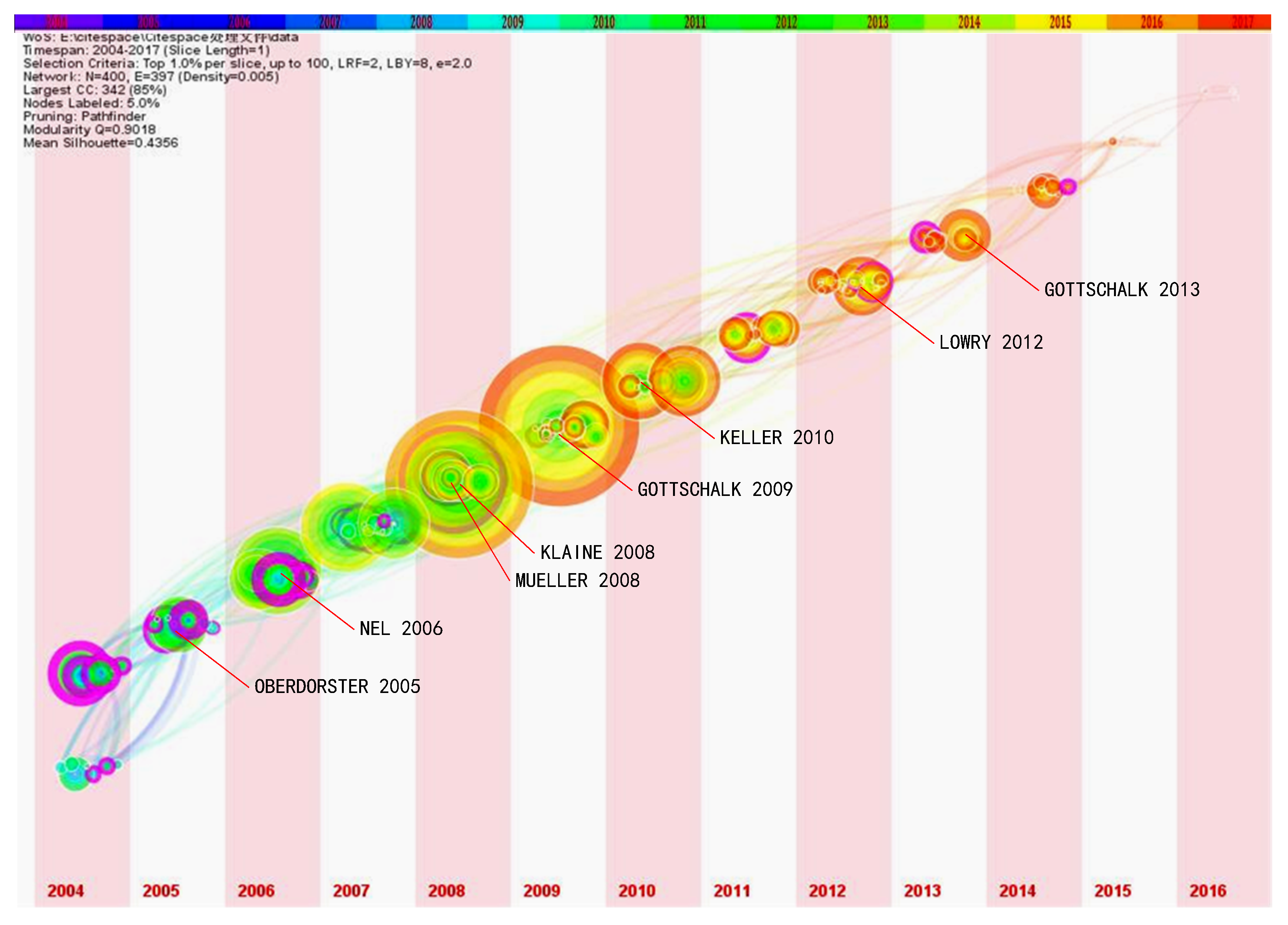

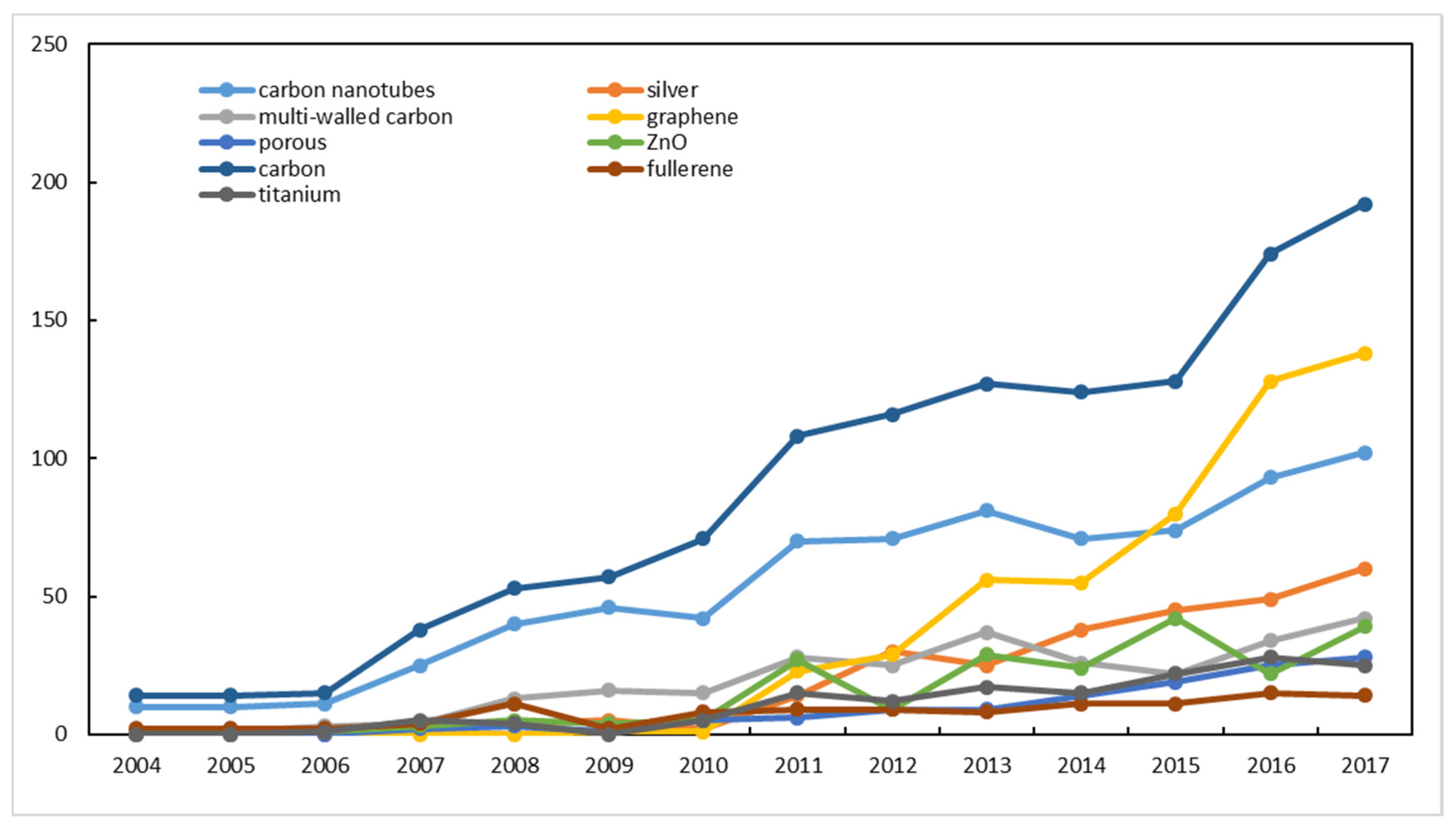
| Year | TP | TLCS | TGCS | AU | AU/TP |
|---|---|---|---|---|---|
| 2004 | 27 | 497 | 3121 | 188 | 6.96 |
| 2005 | 40 | 859 | 6672 | 191 | 5.03 |
| 2006 | 55 | 1487 | 8147 | 255 | 4.64 |
| 2007 | 110 | 1795 | 11,503 | 493 | 4.61 |
| 2008 | 203 | 4763 | 22,751 | 861 | 4.39 |
| 2009 | 278 | 4378 | 24,158 | 1264 | 4.53 |
| 2010 | 366 | 3334 | 24,546 | 1782 | 4.84 |
| 2011 | 553 | 3451 | 34,728 | 2672 | 4.82 |
| 2012 | 610 | 3799 | 34,475 | 3450 | 5.59 |
| 2013 | 707 | 2575 | 25,076 | 3439 | 5.25 |
| 2014 | 794 | 2623 | 22,928 | 4343 | 5.34 |
| 2015 | 941 | 1871 | 17,501 | 5212 | 5.46 |
| 2016 | 1127 | 891 | 11,656 | 6190 | 5.43 |
| 2017 | 1276 | 203 | 3866 | 7122 | 5.55 |
| Countries/Territory | TP | TP R | FP | FP R | IIP | IIP R | NII | |||
|---|---|---|---|---|---|---|---|---|---|---|
| China | 2490 | 1 | 35.13% | 2282 | 1 | 32.20% | 627 | 1 | 8.85% | 133 |
| USA | 1998 | 2 | 28.19% | 1450 | 2 | 20.46% | 341 | 2 | 4.81% | 89 |
| South Korea | 359 | 3 | 5.07% | 275 | 4 | 3.88% | 70 | 5 | 0.99% | 22 |
| Iran | 302 | 4 | 4.26% | 288 | 3 | 4.06% | 96 | 4 | 1.35% | 34 |
| India | 298 | 5 | 4.20% | 256 | 5 | 3.61% | 100 | 3 | 1.41% | 38 |
| UK | 287 | 6 | 4.05% | 3 | 15 | 0.04% | 0 | 14 | 0 | 0 |
| Germany | 247 | 7 | 3.49% | 144 | 10 | 2.03% | 30 | 9 | 0.42% | 12 |
| France | 220 | 8 | 3.10% | 127 | 12 | 1.79% | 9 | 13 | 0.13% | 4 |
| Spain | 211 | 9 | 2.98% | 138 | 8 | 1.95% | 30 | 9 | 0.42% | 17 |
| Canada | 210 | 10 | 2.96% | 157 | 6 | 2.22% | 47 | 7 | 0.66% | 23 |
| Italy | 201 | 11 | 2.84% | 133 | 9 | 1.88% | 20 | 11 | 0.28% | 11 |
| Australia | 186 | 12 | 2.62% | 94 | 14 | 1.33% | 19 | 12 | 0.27% | 9 |
| Switzerland | 184 | 13 | 2.60% | 129 | 11 | 1.82% | 26 | 10 | 0.37% | 11 |
| Taiwan, China | 181 | 14 | 2.55% | 156 | 7 | 2.20% | 50 | 6 | 0.71% | 23 |
| Japan | 170 | 15 | 2.40% | 109 | 13 | 1.54% | 36 | 8 | 0.51% | 19 |
| Carbon Nanotube | Silver | Multi-Walled Carbon | Graphene | Porous | ZnO | Carbon | Fullerene | Titanium | |
|---|---|---|---|---|---|---|---|---|---|
| carbon nanotubes | 0 | 129 | 0 | 0 | 0 | 602 | 0 | 0 | |
| silver | 0 | 0 | 0 | 0 | 0 | 0 | 0 | ||
| multi-walled carbon | 0 | 0 | 0 | 0 | 0 | 0 | |||
| graphene | 0 | 0 | 0 | 0 | 0 | ||||
| porous | 0 | 0 | 0 | 0 | |||||
| ZnO | 0 | 0 | 0 | ||||||
| carbon | 0 | 0 | |||||||
| fullerene | 0 | ||||||||
| titanium |
© 2019 by the authors. Licensee MDPI, Basel, Switzerland. This article is an open access article distributed under the terms and conditions of the Creative Commons Attribution (CC BY) license (http://creativecommons.org/licenses/by/4.0/).
Share and Cite
Li, C.; Huang, G.; Cheng, G.; Zheng, M.; Zhou, N. Nanomaterials in the Environment: Research Hotspots and Trends. Int. J. Environ. Res. Public Health 2019, 16, 5138. https://doi.org/10.3390/ijerph16245138
Li C, Huang G, Cheng G, Zheng M, Zhou N. Nanomaterials in the Environment: Research Hotspots and Trends. International Journal of Environmental Research and Public Health. 2019; 16(24):5138. https://doi.org/10.3390/ijerph16245138
Chicago/Turabian StyleLi, Chen, Guohe Huang, Guanhui Cheng, Maosheng Zheng, and Nan Zhou. 2019. "Nanomaterials in the Environment: Research Hotspots and Trends" International Journal of Environmental Research and Public Health 16, no. 24: 5138. https://doi.org/10.3390/ijerph16245138
APA StyleLi, C., Huang, G., Cheng, G., Zheng, M., & Zhou, N. (2019). Nanomaterials in the Environment: Research Hotspots and Trends. International Journal of Environmental Research and Public Health, 16(24), 5138. https://doi.org/10.3390/ijerph16245138







